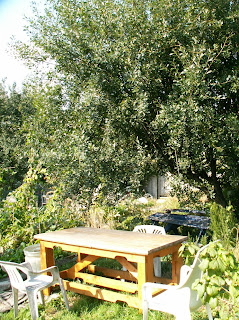viscous/gravitational/inertial/inertio-gravitational
As Field Study's Man in E11, I have been immersed (lost) in the fluid dynamics of honey this last week. Our honey harvest or extraction for 2013 is very nearly complete and I can report we have a yield of 62Kg from our apiary of 2 hives. Both honey bee colonies were left at least 45Ib/20Kg of stores to which they can add for the autumn and winter. Last year we did not harvest any honey and we also chose (by necessity?) to feed the bees through the autumn and winter because the stores were so meagre. I'm pleased with this yield and I like the flavour and other qualities of the honey. One of the other qualities of honey that appeals to me is the viscosity of the liquid and how it behaves when poured. Here is a selection of images from the extraction and jarring process.
a frame of capped honeycomb from a beehive
we sliced the wax capping off using knives heated in hot water
the wax capping was saved to return to the bees
The honey in the uncapped frames was extracted using a motor driven extractor that spins the frames at high speed and so forces the honey out centrifugally. The extracted raw honey, along with various other bits of detritus (wax, dust, pollen, bits of plant), accumulates in the bottom of the extractor. We transferred the raw honey to a storage bucket from which it was poured into and through a muslin filter, to prepare it for jarring up.
While there are possibly various ways of speeding this process up I don't know about them. Part of the appeal of the process to me is the pace of it determined by the qualities of the materials - the found temporal nature of it.
a honey tail and coil
Many hours this last week have been lost and found in the ephemeral sculpture or sculpting of our honey - it's glistening fluid density, aromatic kinematic viscosity, the rhythm of stokes and poise, the gentle diffusivity of momentum accumulating in a viscous flow and slowly draining pool of bubbles.
Field Study's Man in E11 has fantasized about installations of artfully poured honey and other liquids - a sort of 'poor art' (oh dear!) or 'Arte Povera' based on the elemental stuff of his allotment doings. Such fanciful notions may well express his petit-bourgeois affectations.
Meanwhile the true workers in the field have been reunited with some of their plundered winter supplies and I hope to present what they have made of it soon.
cappings returned to bees - 23rd August.































